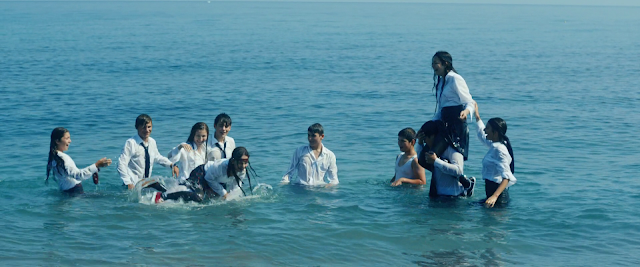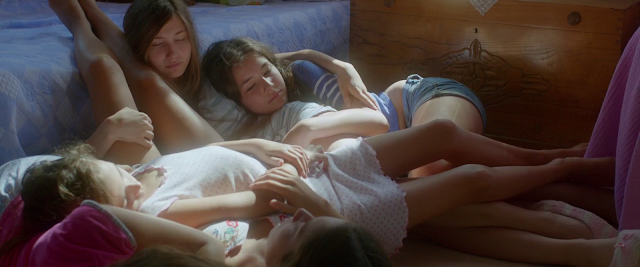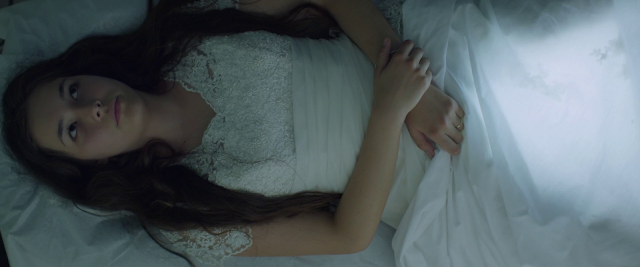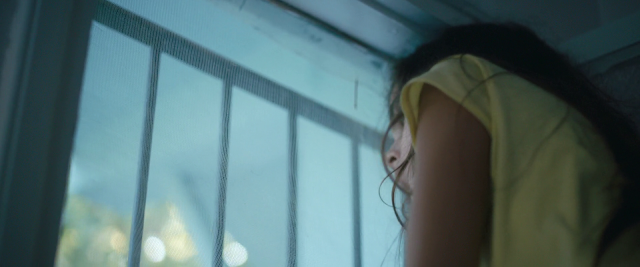In the book of Genesis Adam and Eve live in the garden of Eden among many temptations that God has laid before them to test their faith. One such temptation is the “Tree of Knowledge” or the tree of life. The tree of knowledge is a metaphor for free will, and if anyone eats from the tree of knowledge they become “like god”. Eve eats an apple from the tree after great temptation from Satan in the form of a snake and she is made into a scepter of fallen grace, because she dared question her rulers who “knew better” and convinced Adam to do the same. Eve is every woman who ever sought liberation, and like Eve the women who suffer and languish under strict patriarchal rule in Mustang also take of that apple.
Mustang begins as a breezy summer picture. The girls have ruffled sleeves on their blouses and smiles on their face as they cheer out “Let’s walk, the weather’s nice”. The end of school begats horseplay in an inviting ocean as summer arrives and nothing could appear to be dangerous about this situation, but they made the mistake of having fun with boys. When word got out to their grandmother and uncle that they had been engaging in this activity it meant handcuffs, cages and control, because a woman who plays with boys eventually has sex, and in this small patriarchal community nothing could be more abominable.
Director Deniz Gamze Erguven does a good job of introducing visual confinement over her motion picture. The grandparents are from an older way of thinking where a girls chastity was tied into her value as a wife, and in their panic to preserve their granddaughters they slowly begin to build walls around them as they sell their five adopted children off to eligible bachelors. In the beginning of Mustang the camera has an elegance in frame that mirrored the young girls personalities, and when the walls go up the camera remains intuitive to their perspective but instead of the curiosity of the world inviting exploration the eye is dominated by mundane household activities and an introduction of rhythm and repetition in the girls lives, as every woman in their community has taught them this is their definitive role. There is no safe space in the home of this sisterhood either, and all five girls eventually start striving for their own spots in the house-jail to relax. The older siblings sunbathed through a crack in the exterior. The youngest girl literally plans an escape just to go to a soccer game, which coincidentally was attended by only women after rioting caused by male attendees ruined the national team’s previous game. This notion of a safe space is in the visual language and finding a fracture inside of their of their home built upon an architectural chastity belt becomes paramount. As the walls become more densely layered with steel and spikes the house begins to resemble something between a castle and a prison- a blunt metaphor if there ever was one, but appropriate in its usage here- and the only truly safe space becomes the arms of the sisterhood. In many frames the camera lingers on their symbiotic relationship. The girls are a tangle of limbs, a web of skin providing support where there otherwise was none and it becomes a recurring visual motif as the web is untangled and their sisterhood altered as each girl one after the other, getting younger and younger is married off to a suitor.
“You’ll learn to love your husband” but what if they never wanted one in the first place? The compulsory decision making of their uncle, and to a lesser extent their grandmother a representative of a larger cultural problem all around the world where views on women are archaic is driving force of the conflict. In a previous film I watched for the Female Filmmaker Project, The Day I Became a Woman, there is a long section of the film devoted to one woman who escapes her husband by disobeying him and competing in a bicycle race. In that movie the feminist text of the film is refashioned into an action picture through long tracking shots, overhead camera work and an attention to detail that makes the escape invigorating, terrifying and personal. Mustang goes for something similar in the latter half of the movie when the feminist text becomes genre by adapting the prison break trope. It’s a relatively standard idea considering the already in place prison metaphor, but it works because of a smart decision to align the escape with the wedding of the second youngest child. There are legitimate stakes in what the two girls are trying to elude at this point as we’ve already seen the previous sisters suffer under sexual violence in their marriage or plan their own much more dire escape through attempted suicide. This is their last chance to make it to Istanbul. To find their own liberation. Erguven’s choices as a director in these final moments are solid. The foliage and cages become peepholes and escaping the maze of steel is like a lesser version of the climax in The Shining. There is never a clear view of the Uncle as he trudges through the steel walls behind them, and the camera stays almost exclusively in the girls point of view which only makes the final moments more tense and worthy of its genre rhythm.
Mustang is a film whose text is woven into feminist theory as well as personal women’s narratives, but it also functions as a folk tale. “The girl(s) who have been locked away in the tower” has been around literature and cinema for a very long time. In the older Disney animated pictures there would need to be a prince to whisk the innocent maiden off to safety, but those narratives were always reliant on good men earning a prize. It was a male hero’s journey instead of a self actualized story about women. The metaphorical dragon in Mustang is an ingrained culture of men making decisions for women and having abject control over their respective bodies. But in Mustang there is no prince. The sisters have to be their own saviours, and while that seems to blur into the strong female character archetype that oftentimes reduces women in action pictures here it is an inborn strength through desperation, and not one achieved through violence. Mustang comes from a Turkish mindset first and foremost, but there are other similar narratives throughout cinema that prove dominance over women is bound to Earth in various forms of severity. Sofia Coppola’s The Virgin Suicides and Isao Takahata’s The Tale of Princess Kaguya are two others on the same family tree as Mustang, and the list goes on and on all the way back through the history of cinema whether the director was Kenji Mizoguchi or Ida Lupino. Cinema is a mirror into reality, and one doesn’t need to look far to see that often in movies women are struggling under the control of some force whether it be societal or personal just because we ate of an apple.





Be First to Comment